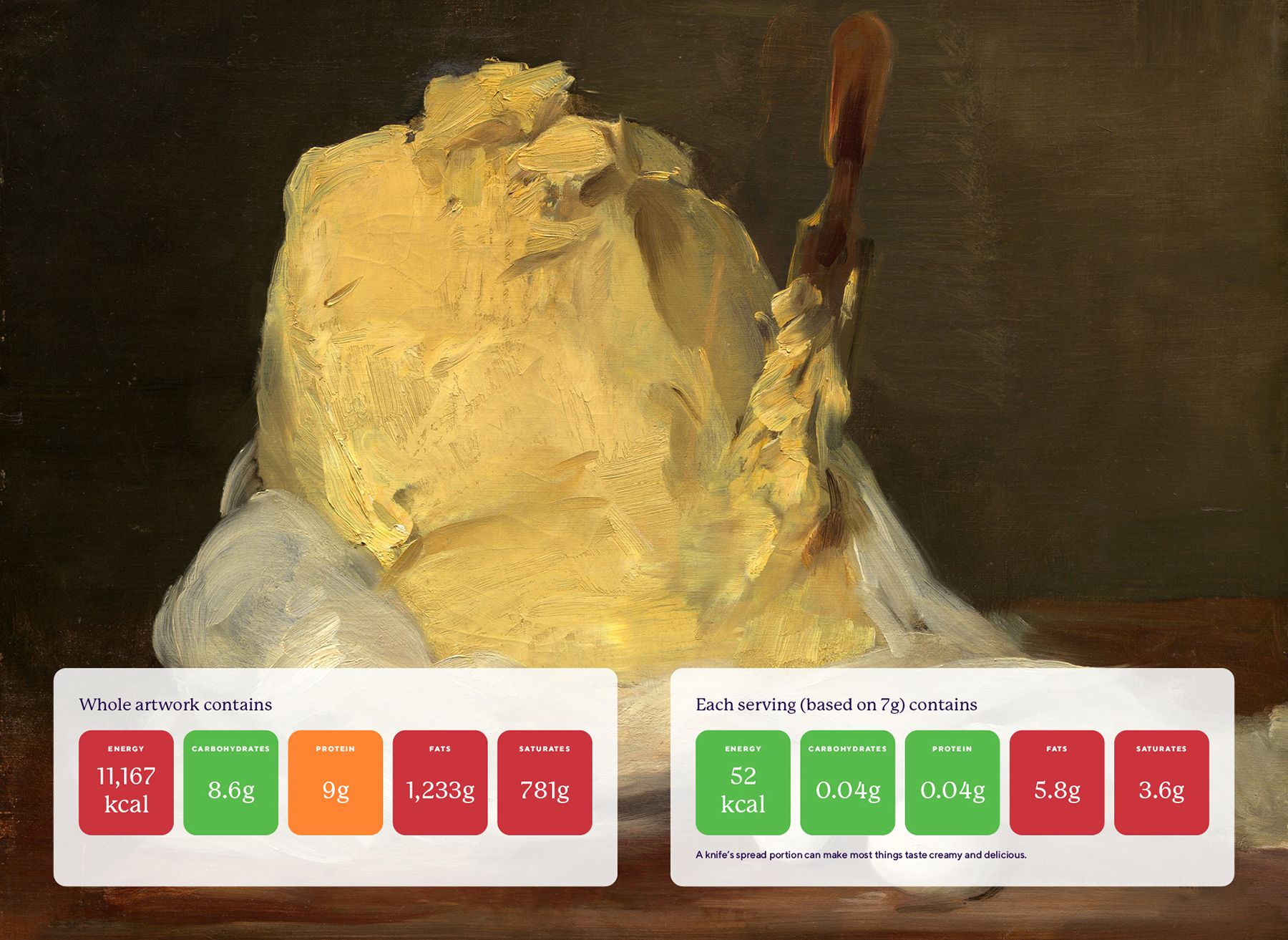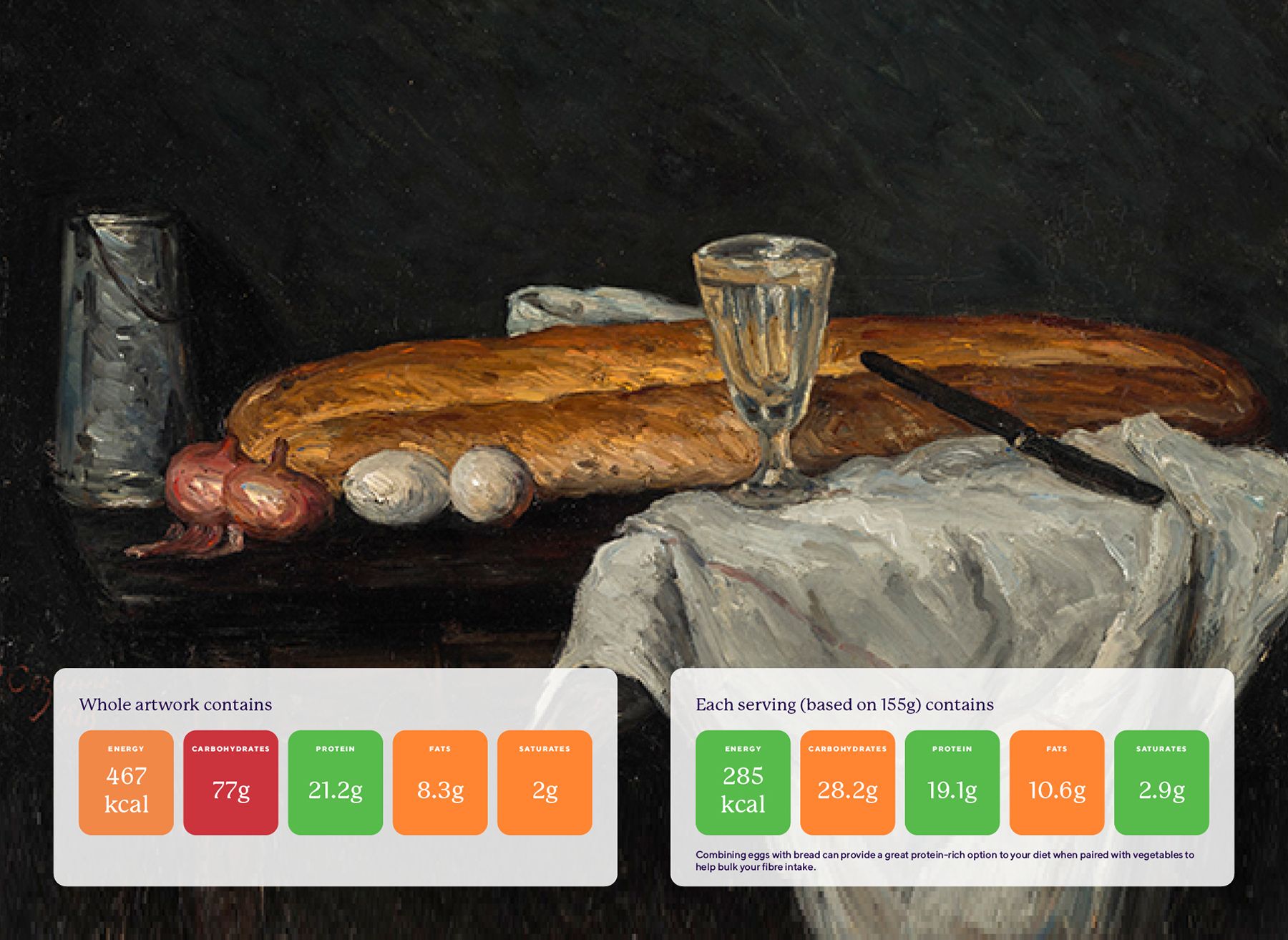Nutritional experts analyse still life works by artists including Salvador Dalí, Paul Cézanne and Frida Kahlo and apply supermarket-style nutritional information labels to them.
Dalí’s surrealist Lobster Telephone artwork and Edouard Manet’s “Fish” both get a mostly ‘green rating’ while Antoine Vollon’s 1.5kg “Mound of Butter” tips into mostly ‘red’.
Artwork “traffic lights” aim to highlight how being armed with the right information can make food easier to navigate and enjoy – just as context helps to better understand great masterpieces.
Whether it’s an overflowing basket of apples, a giant mound of butter or several cans of tomato soup: the art world has given us some of the most iconic and memorable depictions of food ever. Of course, artists like Cézanne and Manet painted their still life masterpieces long before nutritional science enabled consumers to make fully informed choices about their diets, portion sizes and overall nutrition.
Today, to reiterate the benefits of being informed when it comes to food choices, nutritional experts at Voy have applied standard supermarket nutritional information traffic light labels… to still life artworks.
That’s correct: one can now admire Antoine Vollon’s Mound of Butter or Paul Cézanne’s Basket of Apples while also understanding the quantities of fat, saturates, proteins, sugars and calories these world famous canvases depict.
Importantly, to stress that there are no ‘good’ or ‘bad’ foods - and that all foods are beneficial as part of a balanced diet - each painting’s traffic light label provides the total quantities of energy, fat, saturates, sugar and salt as well as the artwork’s guideline daily serving that comprises a sustainable, balanced approach to nutrition.
Still life paintings given the nutritional information treatment by the experts at Voy include:
Paul Cézanne: Basket of Apples
1294 Kcal / Carbohydrates 283g / Protein 14.3g / Fats 11.5g / Saturates 2.9g

Nutritionist’s advice: “Perfect for a light snack, an apple is a great way to add fibre to your diet. Pair with nut butters or a handful of mixed unsalted nuts to stay fuller for longer.”
Edouard Manet: Fish
465 Kcal / Carbohydrates 4.1g / Protein 90g / Fats 10g / Saturates 3.6g

Nutritionist’s advice: “Rich in omega 3s (DHA and LHA) and great at supporting your heart, blood vessels, lungs and your immune and hormone systems, fish provides your body with vitamins A and D and adds a delicious protein option to a balanced diet. You could pair a fillet of salmon, cod or sea bass with some fresh lemon, some mixed roasted vegetables and mixed grains like quinoa, brown rice and pearl barley to create a really delicious dinner"
Antoine Vollon: Mound of Butter
11167 Kcal / Carbohydrates 8.6g / Protein 9g / Fats 1233g / Saturates 781g

Nutritionist’s advice: “Generally, when portioning butter we wouldn’t consume a 1.5kg portion. However, a knife’s spread portion on toast or cooked up with a few button mushrooms or topped on our potatoes, can make most things taste creamy and delicious, especially when paired with some pepper and salt.”
Pieter de Ring: Golden Goblet
1749 Kcal / Carbohydrates 350g / Protein 66g / Fats 9.6g / Saturates 1.7g

Nutritionist’s advice: “Fruits can add real variety to the fibre and nutrients of any dish and should always be considered alongside our choices of vegetables, proteins, fats and carbohydrates. Adding a portion of fruit to your plate like a bit of melon, a slice of orange or a plum could be a delicious finish to a fish-based main course.”
Paul Cezanne: Bread and Eggs
467 Kcal / Carbohydrates 77g / Protein 21.2g / Fats 8.3g / Saturates 2.g

Nutritionist’s advice: “A staple for many of us, combining eggs with bread can provide a great protein-rich option to your diet. Pairing the recommended portion of ½ a baton and a couple of eggs alongside with some roasted tomatoes, mushrooms and spinach, can help to bulk your fibre and phytonutrient intake and help you feel fuller for longer.”
Some additional paintings that have been assessed include and are linked to here:
Frida Kahlo, Viva la Vida Watermelons

Nutritionist’s advice: “A few slices of watermelon is a delicious way to get more hydration into your diet and can be the perfect thirst-quenching snack. You could elevate the humble watermelon slice with a drizzle of lime and a sprinkle of chilli to make it taste even better on a hot summer’s day.”
Salvador Dalí, Lobster Telephone

Nutritionist’s advice: “Although we wouldn’t recommend cooking your lobster with a telephone, lobster can be a delicious addition to your diet. Lobster with its prawn-like flavour is perfect for pairing with mixed potatoes and a fresh salad.”
Emily Wood, a nutritionist from weight loss brand Voy (joinvoy.com) commented “We know that on the face of it, it seems madness to ‘reduce’ masterpieces to a series of coloured boxes and numbers when there is so much more going on in these paintings. Art is all about context and just as there are an abundance of factors and subtleties at play in every painting; so too when we are choosing what to eat and how these foods will bring us joy, nourishment or both.
We wanted to use some of the world’s most iconic depictions of food to remind people that no food is simply ‘good’ or ‘bad’. Just because a food item has red traffic lights doesn’t mean it’s off limits. Likewise, only eating foods with green traffic light labels isn’t necessarily a good thing for the body or the mind. It’s all about balance and giving people the information and the context they need to make balanced food choices which work for them.”
According to the Food Standards Agency (FSA), “Whilst it is mandatory for nutrition information to be displayed on the back of all food packaging, some supermarkets and food manufacturers also display nutritional information on the front of pre-packed food in a handy traffic light system”.
This as a survey of consumers by the FSA* showed 69% of shoppers actively sought healthier options but only 45% used the traffic light labelling system when shopping for food. Furthermore some foods are exempt from this system entirely (such as alcohol) and consumer decision-making confidence is further eroded by manufacturers’ misleading suggestions for recommended portion sizes, as revealed by a recent Which? report**. When one also considers the reams of media articles on everything from miracle health foods to ultra-processed foods (UFPs) it’s no surprise even the most well-informed consumer can feel bamboozled by a trip to the local convenience shop, let alone a foray into delivery apps, markets, street stalls, restaurants - or indeed art gallery cafes.
Eating Better Choosing Well tracker published by the Food Standards Agency, 2023 (N.I.) https://www.food.gov.uk/sites/default/files/media/document/EWCB%20tracker%20survey%20wave%208.pdf
Which? report, July 2023: https://www.which.co.uk/policy-and-insight/article/portion-sizes-are-inconsistent-unrealistic-and-confusing-which-finds-adbYi0V3XhV7




